Cosmic Microwave
Background Radiation
Introduction
Cosmology is the study of
our universe. The modern cosmology has begun when the general theory
of relativity was founded by A. Einstein and the cosmic expansion was
observed by E. Hubble. The development of realistic cosmological
models has been accelerated with the discovery of the 2.7 K blackbody
radiation that exists everywhere homogeneously and isotropically.
Since the intensity of the thermal radiation is strong at microwave
band, we simply call it the cosmic microwave background radiation
(CMB). The existence of CMB indicates that the universe was in a very
hot phase at the early epoch and was filled with hot, uniform soup of
fundamental particles, and has been considered as direct evidence for
the Big Bang. Although the Big Bang model can explain the abundance
of light elements such as hydrogen, helium, and lithium, it cannot
explain inhomogeneous matter distribution we observe today.

|
According to the standard cosmological model,
the large-scale structures have been formed from the primordial matter
fluctuations through the gravitational evolution during over 10 billion
years. The primordial fluctuations, which are expected to have
fractional amplitudes of 10-5 at superhorizon scales, were discovered by the COBE/DMR in
1992 as minute fluctuations in CMB temperatures (anisotropy). The
theory of adiabatic initial condition and inflation has been successful
in explaining the origin of the primordial fluctuations, giving
predictions consistent with the present observation of the CMB
anisotropy.
|
Figure 1: Brief History of the
Universe (http://lambda.gsfc.nasa.gov)
What is CMB
anisotropy?
The CMB radiation anisotropy is a snapshot of the
universe when it was only 380,000 years, and is a unique tool for
probing the early universe because it directly reflects the early
matter fluctuations of the universe.
The WMAP observess the minute
temperature fluctuations at 23-94 GHz frequency range, with maximum
angular resolution of 0.21 degree.
|
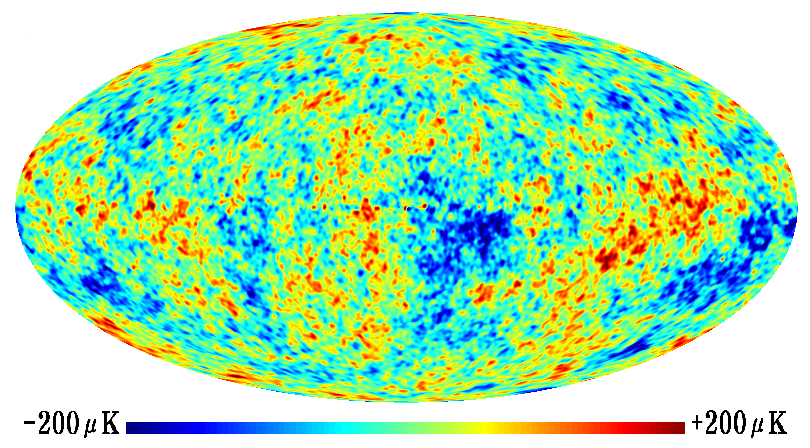
|
In practice, the observed temperature
fluctuation is the sum of the CMB signal, instrument noise, and
contaminating signals from the Galactic and extragalactic sources. For
accurate measurement of statistical properties of CMB, subtracting the
foreground contribution is very important.
For example, a foreground-reduced CMB map is shown in Figure 2, where
the map has been produced from the linear combination of five WMAP maps
at different frequencies by constraining the variance of the combined
map to be minimized
|
Figure 2: A foreground-reduced CMB
temperature anisotropy map (1.4 degree resolution) produced by
applying the internal linear combination method (Park, Park &
Gott 2007).
The
CMB photons were linearly polarized when they last-scattered with
electrons at the decoupling surface.
|
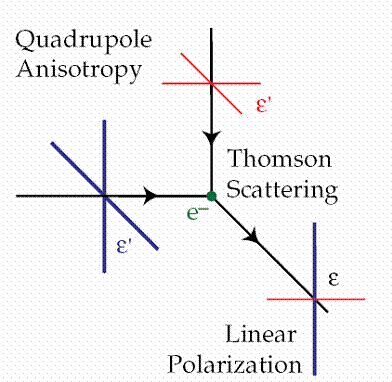
|
Just before recombination, photons of different
energies scatter off electrons via Thomson Scattering.
Scattering off one electron is illustrated on the left.
Effectively, a partial polarization amounts to
different intensities along two axes. The only way to produce different
intensities along two axes after scattering is as shown, i.e. when the
two incoming photons with different energies have an angle of 90o
between them. In other words, incoming radiation has a quadrupole
anisotropy.
|
Beause
the polarization angle and intensity are tightly related with
radiation field surrounding the electrons, we expect that the
polarized signal is correlated with temperature fluctuations. The
WMAP satellite has also observed the CMB polarization that is much
weaker (a few μK levels) than the temperature anisotropy.
Brief history of
CMB Observations
|
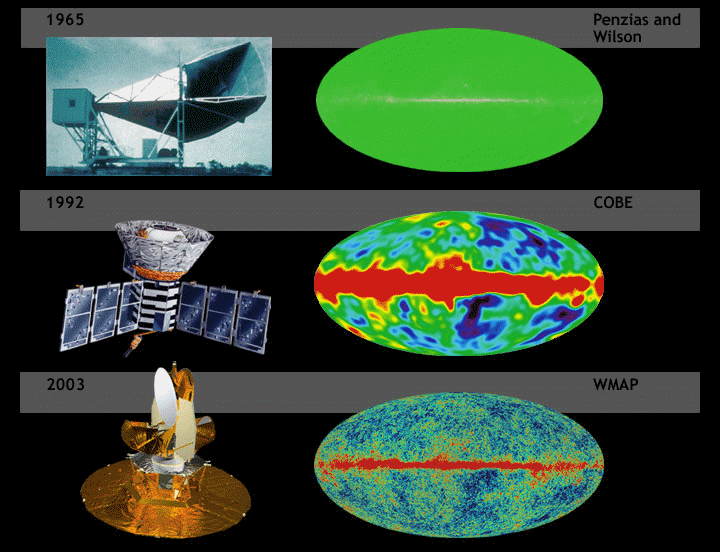
|
CMB radiation was first observed inadvertently in 1965 by Arno Penzias
and Robert Wilson at the Bell Telephone Laboratories. The radiation was
acting as a source of excess noise in a radio receiver they were
building. Penzias and Wilson shared the 1978 Nobel prize in physics for
their discovery.
The COBE satellite was developed and launched by NASA's Goddard Space
Flight Center to measure the CMB anisotropy. The CMB was found to have
intrinsic "anisotropy" for the first time, at a level of a part in
100,000.
The WMAP (Wilkinson Microwave Anisotropy Probe)
mission has measured the CMB anisotropy with greatly enhanced angular
resolution. The skymap from the WMAP observations have 45 times the
sensitivity and 33 times the angular resolution of the COBE mission.
|
Power spectra of
CMB
Because of the matter -photon coupling, minuscule
amounts of inhomogeneities in the matter plasma lead to two opposing
forces – gravity and photon pressure. These set up acoustic
oscillations in
the matter-photon plasma, so the waves-on-a-string analogy works
well. These oscialltions are clearly visible in
the plots below.
Cosmologists often use two-point statistics
(correlation function and power spectrum) as the primary tool for
constraining the cosmological model. If the field is Gaussian, the
statistical property of the field can be completely described by the
two-point statistics. The power spectrum is measured from the density
field by applying the maximum likelihood or Fourier transform
methods. The fluctuations in the density field are decomposed into
waves with different wavelengths, and the power spectrum is obtained
as the amplitude variance of the waves at each wave number. For CMB
data, angular power spectrum Cl
at each multipole l
is measured from the spherical harmonic expansion of the
temperature fluctuations on the sphere.
The power spectra measured
from the WMAP CMB temperature and polarization data are shown in
Figure 3, where power spectra of other CMB experiments are plotted
for comparison. Two model power spectra of the best-fit ΛCDM model
and flat CDM model with Λ=0 are also shown below.
|
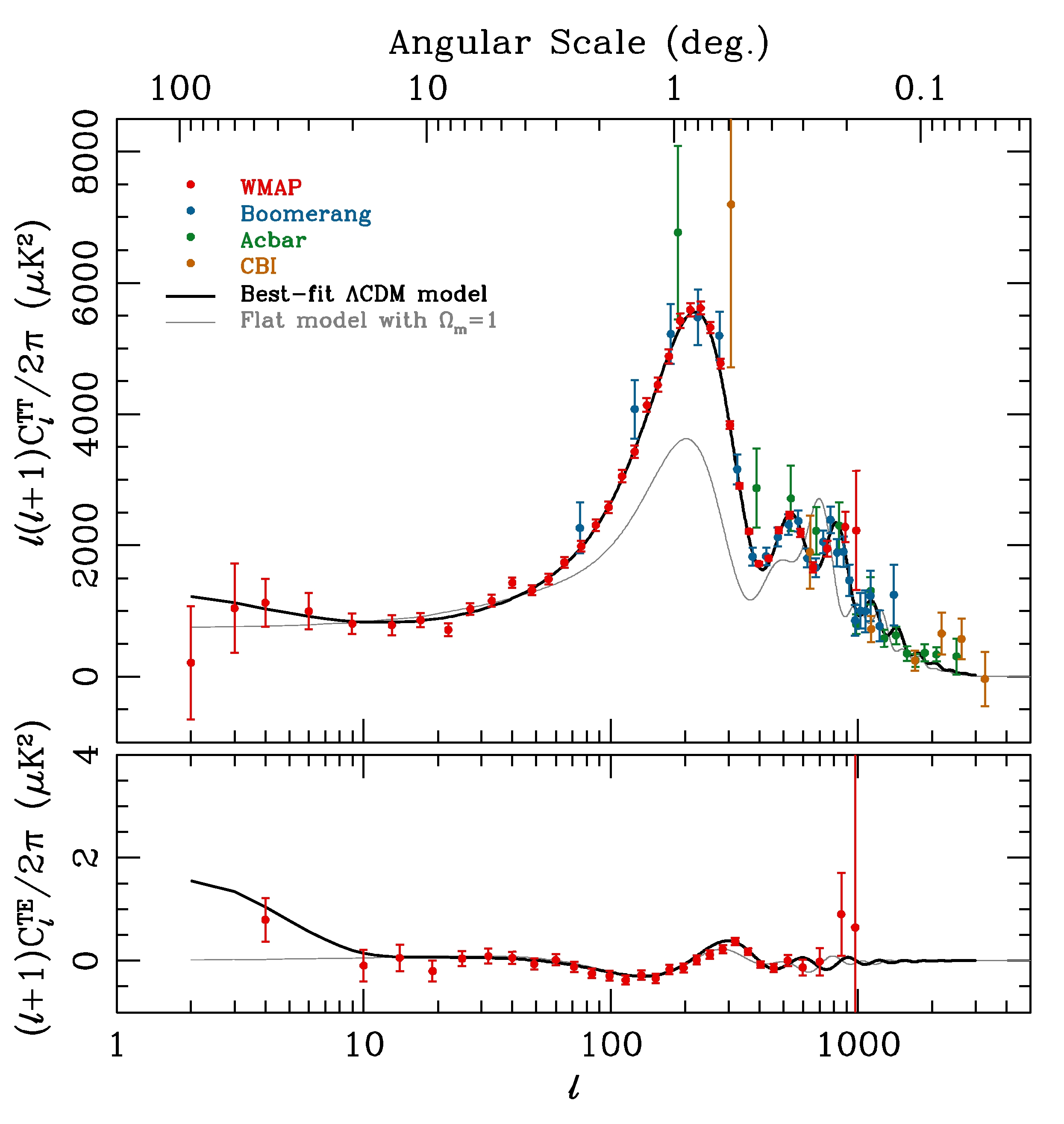
|
The appearance of the CMB anisotropy power
spectrum implies that our universe started from the adiabatic initial
conditions.
The first acoustic peak is obviously seen in
the temperature (TT) power spectrum at l=220
(about 0.8 degree scale). The location of the first acoustic peak
corresponds to the sound horizon size at the decoupling epoch. Inside
the horizon, acoutic modes of photon-baryon fluid were oscillating with
compression and rarefaction, which induce a series of acoustic peaks
and troughs.
In the temperature-polarization (TE)
cross-power spectrum, non-zero correlation on both large (from
reionization) and small (from adiabatic fluctuations) angular scales
have been detected . Especially, the former is the signature of
ionization of primordial hydrogen and helium due to the formation of
the first stars and galaxies. The detection of the reionization of the
universe corresponds to an optical depth τ = 0.088, and an epoch z=11
(or t=400 Myrs after the Big Bang).
|
Figure 3: Angular power spectra
measured from CMB temperature and polarization data from WMAP, Acbar,
Boomerang, and CBI, denoted as ClTT
for temperatures and ClTE
for temperature-polarization
cross-correlation.
What we
learned from CMB study?
The WMAP team has derived cosmological parameters
from the temperature and polarization power spectra of the WMAP
3-year data.
The CMB temperature and polarization data implies that
the observed CMB fluctuations are consistent with predictions of
the
concordance flat ΛCDM model with adiabatic fluctuations which have
been generated during the inflationary epoch. The
most important result is that the energy content of the universe is 76%
of dark energy and 24% of matter. The ordinary matter (baryon)
contributes only 4% to the total energy content. The luminous stars and
galaxies that we see today are only a small part of the total material
in the universe. The most material exists as dark matter. Furthermore,
the present universe is dominated by the dark energy, and is being
accelerated.
Future CMB mission
|
Planck is a European Space Agency (ESA)
mission.
Planck will be the third generation CMB space mission
following COBE and WMAP. Its goal is to get the highest
precision, highest resolution, and cleanest maps resulting in the best
data. It will also combine the best test of cosmological models with
the best estimates of cosmological parameters - bringing cosmology into
a new age.
|
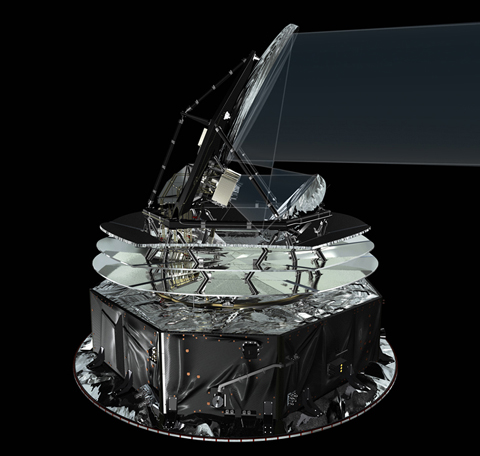
|
CMB research at
KIAS
The KIAS cosmology group studies the statistical
properties of the CMB anisotropy. For this purpose, the group have
been developing efficient algorithms to remove the Galactic
foreground emission in the observed CMB maps. Anothor research
subject is to quantify the level of non-Gaussianity from the observed
CMB temperature fluctuations. For example, the genus statstic can be
measured from the WMAP data to test for the Gaussianity of such
primordial fluctuations.
우주배경복
사
우
주론은 과학적 사고와 관측 자료 분석을 통하여 우주의
생성과 진화에 관한 의문점을 풀어가는 과학의 한
분야이다.
현
대우주론은
아인슈타인(Einstein)이
1915년
일반상대성 이론을 확립하고,
1917년
균일 등방한 정적인 우주모형을 제안하면서 시작되었다.
1920년
대에
들어와 프리드만(Friedmann)은
우주의 팽창과 수축을 포함하는 더욱 일반적인 우주
진화식을 유도해 내었고,
로
버트슨(Robertson)과
워커(Walker)는
프리드만 우주모형의 이론적 토대를 보완하여 현재
프리드만-로버트슨-워커(FRW)
우
주모형으로
불리는 균일 등방한 우주에 관한 물리적 모형을
완성하였다.
1929년
허블(Hubble)은
외부은하의 후퇴속도와 거리의 비례관계(허블의
법칙)로부터
우주의 팽창을 발견하였는데,
이
보다
앞서 르메트르(Lemaitre)는
허블의 법칙을 이론적으로 유도하였을 뿐만 아니라
물질,
에
너지가
한 점에 집중된 상태에서 우주가 생겨나 팽창해왔다는
내용의 대폭발 우주모형을 처음으로 생각해냈다.
허
블의
우주팽창 발견은 대폭발 우주모형을 뒷받침하는 결정적인
증거로 생각되고 있다.
대폭발
모형과 우주배경복사는 무엇일까?
대부분의
과학자들은 우리우주가 약 137억
년 전 극도로 뜨거운 상태에서 대폭발과 급팽창을
겪으며 생겨났다고 생각하고 있다.
대폭발
우주모형에 따르면,
태초의
뜨거운 우주 속에는 빛,
전자,
양성자와
같은 수많은 기본 입자들이 서로 뒤섞여 충돌하며
열적평형상태를 유지하고 있었다.
열적평형상태의
빛은 플랑크의 흑체복사 스펙트럼을 갖는다고 알려져
있으며 흑체복사의 온도만 알면 특정 진동수에서 빛의
세기를 정확히 알아낼 수 있다.
이
흑체복사의 온도는 우주가 팽창함에 따라 내려가는데
이는 공기를 단열 팽창시키면 공기가 차가워지는 원리와
비슷하다.
우주의
나이가 38만년
정도 되었을 때,
팽창하며
식어가던 우주의 온도는 약 3000
K 정도로
내려갔고,
이온화돼
있던 수소와 헬륨 원자핵과 자유롭게 날아다니던 전자는
서로 달라붙게 돼 중성원자를 형성하였다.
빛과
숱하게 충돌하던 전자가 급격히 사라져버리자 빛은
물질과 더 이상 부딪치지 않고 자유롭게 우주공간을
퍼져 나가기 시작하였는데,
이
시기를 빛의 분리시기(decoupling
era) 또는
재결합시기(recombination
era)라고
한다.
이
빛은 흑체복사의 스펙트럼 성질을 그대로 간직한 채
아직까지도 우주를 떠돌아다니며 식어가고 있다.
우주
전체에 균일하게 퍼져 있는 이 빛을 우주배경복사(宇宙背景輻射,
cosmic microwave background radiation)라고
한다.
우주배경복사는
현재 2.73
K인
차가운 흑체복사로 존재하며,
대폭발에
의한 우주 기원설을 뒷받침하는 직접적인 증거로
생각되고 있다 (그림
1).
우
주거대구조,
은
하단,
은
하,
별,
태
양계에
이르기까지 갖가지 규모의 우주 구조들은 모두 물질의
중력수축에 의하여 생겨났다.
만
약
초기 우주의 물질분포가 균일하였다면 이들은 생성될
수 없으며,
중
력수축에
의한 구조형성은 반드시 물질분포의 요동(fluctuation)이
존재해야만 가능하다.
과
학자들은
우주거대구조의 씨앗이 존재하였을 것이라는 점과
우주배경복사가 빛의 분리시기 불균일한 물질분포에
대한 정보를 담고 있을 것이라는 점으로부터 우주배경복사의
온도는 하늘을 바라보는 방향에 따라 절대온도 2.73
K의
10만분의
1
정
도
달라지는 미세한 온도 변화(수십
μK)를
지니고 있을 것으로 예측해 왔다.
이
를
우주배경복사 온도의 비등방성(anisotropy)이라고
한다.
우
주배경복사의
비등방성은 재결합 시기(t0=38
만
년)
우
주의
모습을 찍은 사진이자 우주 구조형성의 초기조건을
담고 있는 암호문이다.
코
비의
뒤를 이어 발사된 WMAP은
우주배경복사의 온도요동을 23~94
GHz 주
파수
영역에서 0.21°
고
해상도로
더욱 정확히 관측하여 표준우주모형을 구성하는 우주론적
계수들(cosmological
parameters)이
수 %
정
밀도로
결정될 수 있도록 하는 등 우주론 연구에 획기적인
발전을 가져왔다.
그
림
2은
WMAP
위
성이
3년
동안 관측하여 얻어낸 자료에서 우리은하의 강한
방출선을 제거하여 나타낸 우주배경복사의 온도
요동지도이다.
\
구
면 상의 복잡한 요동은 파장이 긴 것부터 짧은 것까지
다양한 파동으로 분류해 낼 수 있으며,
WMAP이
관측한 배경복사의 온도요동도 파장이 90°~0.21°인
다양한 파동의 조합으로 기술할 수 있다.
그
림
3은
WMAP의
3년
관측 자료로부터 측정한 우주배경복사 온도요동(위)과
온도-편광
상관성(아래)
파
워스펙트럼이다(빨간색).
온
도요동의
파워스펙트럼 그래프에는 코비 DMR
자
료에서
얻은 파워스펙트럼(노란
다이아몬드)과
최근 Boomerang(파란색),
Acbar(녹
색),
CBI(갈
색)
실
험에서
얻은 결과들이 함께 표시되어 있다.
굵
고
검은 곡선은 암흑물질과 암흑에너지로 차있는 평탄한
우주모형의 이론적 예측을 나타낸다.
회
색
곡선은 암흑물질로만 채워진 평탄한 우주모형의
예측으로서 WMAP의
관측 결과와 잘 맞지 않음을 보여준다.
WMAP 우
주배경복사
온도요동의 파워스펙트럼에서 한 가지 중요한 특징은
l=220
가
까이에
첫째 봉우리가 위치한다는 것이다.
파
워스펙트럼에서
첫째 봉우리의 위치는 우주의 기하학적 구조와 밀접한
관련이 있다.
우
주가
평탄하면 l=220에,
닫
혀
있으면 l<220에,
열
려
있으면 l>220
에
위치한다.
따
라서
WMAP
파
워스펙트럼의
첫째 봉우리 위치로부터 우리우주가 매우 평탄함을
알 수 있다.
WMAP과
다른 고해상도 실험의 결과에 따르면,
우
주배경복사의
온도요동은 약 1°
규
모에서
파워가 가장 세며 작은 규모로 갈수록 파워가 증감을
거듭하면서 낮아진다.
WMAP은
1°
이
하
규모에서 나타나는 우주배경복사 온도요동과 편광이
우주 초기에 존재한 단열적(adiabatic)
요
동의
음파진동으로부터 생겨났다는 것을 정확히 밝혀냈으며,
이
는
급팽창 우주모형을 지지하는 결정적인 증거로 생각되고
있다.
현
대우주론의 주요 목표는 천문관측 자료와 가장 잘 맞는
우주모형을 만들고 그 우주모형을 규정짓는 우주론적
계수들을 정확하게 측정하는 것이다.
물
질과
에너지 분포에 섭동을 가해 얻은 표준 FRW
우
주모형에서
빛의 분포함수를 시간에 따라 진화시키면 특정 우주모형에서
예측되는 우주배경복사 온도요동과 편광의 파워스펙트럼을
이론적으로 구해낼 수 있다.
과
학자들은
관측 자료에서 구한 파워스펙트럼을 표준우주모형에서
예측한 이론적인 파워스펙트럼(그림
3의
굵은 선)과
비교하여,
관
측
자료를 가장 잘 맞추는 우주론적 계수들을 찾아낸다.
WMAP 팀
은,
우
리우주가
공간적으로 평탄하며 나이는 137억
년이라는 것,
전
체
에너지 중 바리온(보통물질)이
차지하는 비율은 겨우 4%
정
도이고,
암
흑에너지와
차가운 암흑물질(cold
dark matter; CDM)이
각각 76%와
20%나
차지하고 있는 것을 밝혀내었다.
암
흑에너지는
아인슈타인이 정적 우주모형에 도입하였던 우주상수
Λ로
보통 표현되며,
중
력의
반대 성질을 지니고 있어 현재 우리우주의 가속팽창에
대한 원인으로 생각되고 있다.
우
리우주를
가장 가깝게 기술하는 이 FRW
모
형을
평탄한 ΛCDM
우
주모형이라고
부른다.
고등과학원의
우주론 그룹은 우주배경복사 비등방성의 통계적 특성을
연구하고 있다.
이를
위해, 관측으로
얻어낸 배경복사 자료에서 우리은하의 강한 방출선에
의한 오염을 줄이는 효율적인 알고리즘을 개발하고
있다. 또한,
우주배경복사
온도요동 자료를 사용하여 우주 원시 요동의
정규성(Gaussianity)을
검정하는 연구도 수행 중이다.





